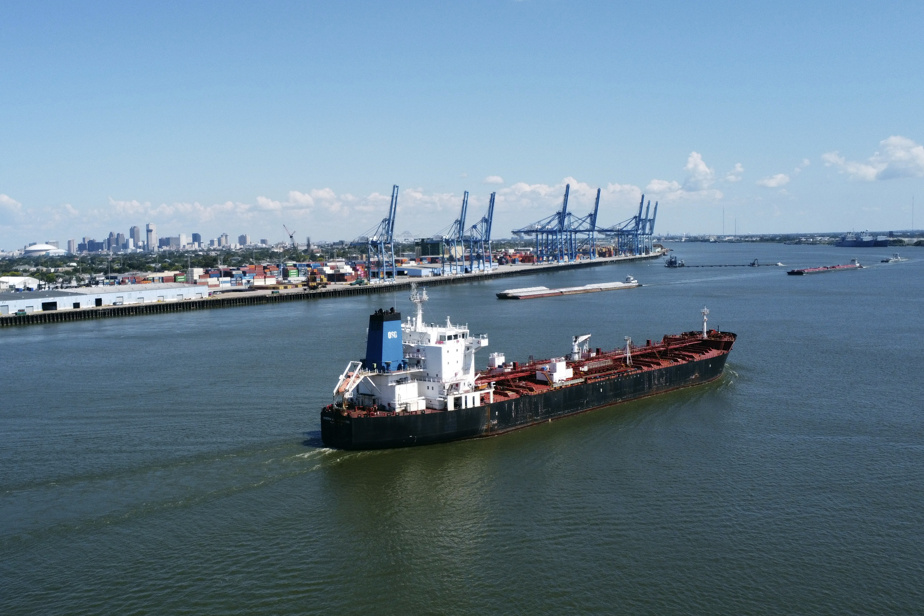The spotlight is on the Port of Montreal after an agreement that will bring 45,000 striking American longshoremen back to work. It remains to be seen how the preliminary agreement, which provides for significant salary increases, will influence the mediation, which resumes this Friday in the metropolis.
Thirty-six ports on the American East Coast have been at a standstill since Tuesday, but common ground between the American longshoremen’s union – the employees who handle the containers – and the employer plans a resumption of activities this Friday.
Details were still preliminary Thursday evening. Until everything is finalized, union peace is expected at least until January 15. The union wants to continue negotiating with the employer on issues like automation at ports – one of the elements at the heart of the dispute.

PHOTO MARTA LAVANDIER, ASSOCIATED PRESS
Protesters in front of the Port of Miami expressed their dissatisfaction with automation and demanded the preservation of their jobs on Thursday.
In exchange, salary increases of up to 62% over six years would have been offered, according to various American media. The union was aiming for a 77% increase. On average, the base hourly rate of a longshoreman would increase from US$39 to US$63, according to the Wall Street Journal.
“With what has been obtained, this gives arguments to the longshoremen [québécois] to demand parity with their American compatriots,” said professor of the department of business administration at Texas A&M University Jean-Paul Rodrigue.
We could say “look, they had these conditions, why not us?”.
Jean-Paul Rodrigue, professor in the department of business administration at Texas A&M University
The Union of Longshoremen of the Port of Montreal, a local section of the Canadian Union of Public Employees, affiliated with the FTQ, as well as the Association of Maritime Employers (AEM), have not commented on the turn of events in the United States , THURSDAY.
The parties talk again
Summoned by the Federal Mediation and Conciliation Service, the two parties will meet again on Friday, the day after the resumption of activities at the Port of Montreal. Since Monday morning, the Viau and Maisonneuve terminals, operated by Termont, have been paralyzed by a partial strike.

PHOTO PATRICK SANFAÇON, LA PRESSE ARCHIVES
Longshore workers at the Port of Montreal ended their partial strike Thursday morning.
Some 320 of the 1,200 longshoremen were on strike. Société Terminalaux Montréal Gateway, which operates two international terminals, was spared. It is unknown whether the union is preparing other pressure tactics and whether the AEM is counting on a response.
If the strike had continued in the United States, there would have been more intense pressure for Montreal workers to stay on the job because gateways to the East Coast would have been limited.
Jean-Paul Rodrigue, professor in the department of business administration at Texas A&M University
Will Montreal longshoremen align their wage demands with what was obtained in the United States? Difficult to say at the moment. According to the collective agreement which expired on December 31, the “basic” hourly wage of a longshoreman is $43.04 per hour, or approximately US$31.95 per hour. Annually, the remuneration of a full-time worker is $171,000, which takes into account social benefits, according to the AEM. Not all union members receive this annual salary.
What is the Maritime Employers Association?
It is the employer of the longshoremen, who load and unload the ships. The Association negotiates and administers the employment contracts of its members in Montreal, Contrecœur, Trois-Rivières, Bécancour, Hamilton and Toronto. It counts terminal operators and shipping companies among its members.
South of the border, more than half of the 3,726 longshoremen at the port of New Jersey earn more than US$150,000 – CAN$202,000 – per year, according to a compilation produced by the Wall Street Journal. Unlike their Montreal colleagues, however, they do not benefit from a retirement plan “fully paid” by their employer and job security – a mechanism which guarantees them a better salary even if they do not work when the volume cargo is insufficient.
Here, issues like hours and job security are at the heart of the impasse. In the initial request books, that The Press had been able to consult, the longshoremen wanted to obtain salary increases of at least 20% over four years. This would increase the base hourly rate to $51.65.
Lost opportunity?
Despite tense labor relations, the Port of Montreal had taken on the appearance of a plan B for transporting containers south of the border due to the labor conflict that was raging.
At Quebec transport and logistics specialists – who often offer bonded warehousing services, where cargo can be stored before arriving at their ultimate destination – the phone started ringing.
“There are many American companies currently evaluating their options,” explained Patrick Turcotte, president of Groupe TYT, before the announcement of an agreement in the United States. There are containers headed to Montreal to transport them to the American East Coast by truck. It’s like a relief valve to remedy the strike in the United States. »
The relaunch of activities in American ports should also reassure food retailers, who have been monitoring the situation. Fruits like bananas as well as oranges – when imported from countries like Morocco, Spain and Portugal – pass through ports on the east coast of the United States.
Learn more
-
- 41%
- Proportion of containers that pass through the Termont terminals annually – those paralyzed by the partial dock workers’ strike
Source: maritime employers association
- 51%
- Annual volumes of containers passing through Montréal Gateway
Source: MARITIME EMPLOYERS ASSOCIATION
